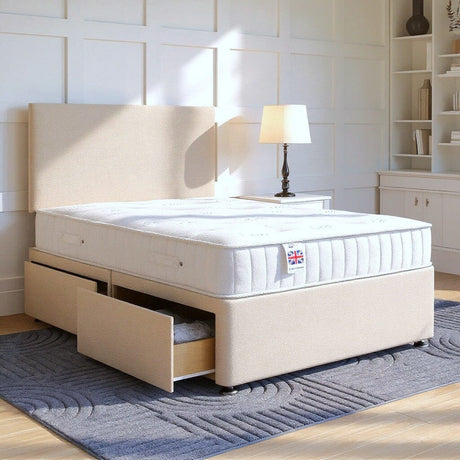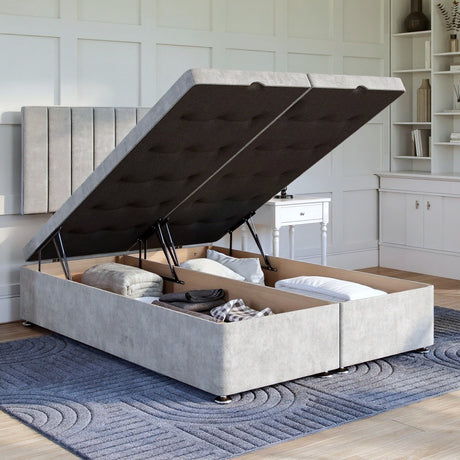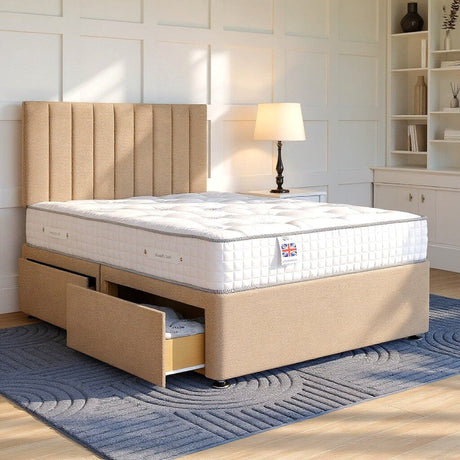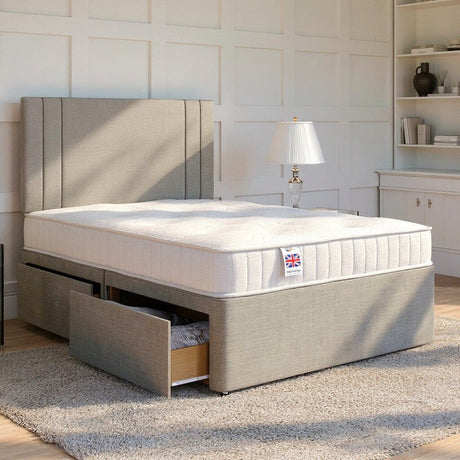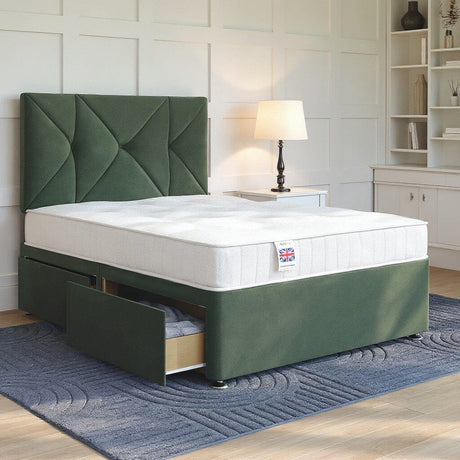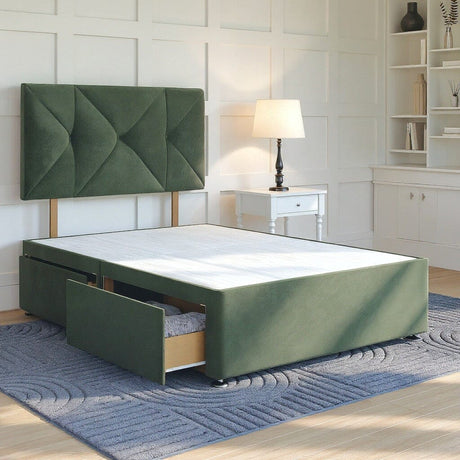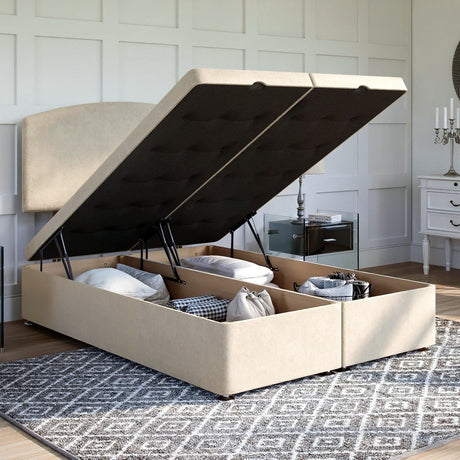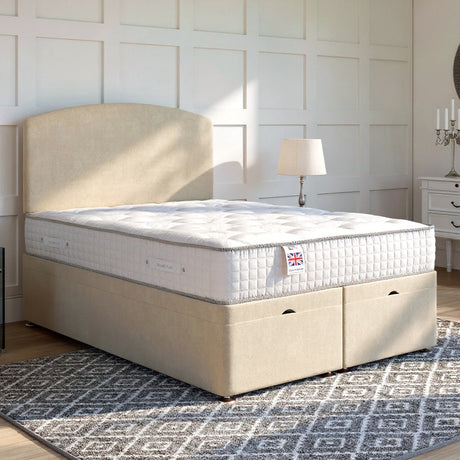Buying a mattress is one of the most important purchases you can make. Get it wrong and you can suffer from a lack of sleep, develop a bad back and even suffer in your day to day life. So, it’s important you get it right. If you want to buy the perfect mattress for you, read our complete guide to buying the right type of mattress now.
Why buying the right type of mattress is important
A mattress is just a mattress right? Wrong! Beyond just having a bad night’s sleep, buying the wrong type of mattress can have a bigger impact on your life than you might think.
Consider the following facts from the Sleep Council:
- 40% of people suffer from sleep issues.
- 20% of road deaths can be attributed to fatigue caused by a lack of sleep.
- 25% of school children are not getting enough sleep.
- Sleep deprivation costs the UK economy £40.2 billion every year!
- On average, when you buy a new mattress you gain an extra 42 minutes of sleep.
We’re sure you’ll agree that those are some pretty eye opening stats. Buying the right type of mattress really can make a difference to you and your loved ones.
We hope the following guide helps you make the best possible choice in mattress.
How often should you change your mattress?
Is it really time to get a new mattress? It may seem easy to put off buying a new mattress - we’ll admit there are plenty of more exciting things to spend money on.
But, as those facts and figures above highlight, living with a poor quality or worn-out mattress really can have a negative impact on your quality of life.
The National Bed Federation recommends that you change your mattress every seven years (although if you have a particularly expensive, high-quality mattress then you can usually get ten years out of it).
Mattress wear and tear
Don’t just take the word of the National Bed Federation though. Over the course of seven years, your mattress will have:
- Been slept on for over 20,000 hours.
- Will have absorbed half-a-pint of fluid every evening (sweat etc).
- Accumulated a pound of dead skin cells each year.
For many people that’s motivation enough to buy a new mattress!
How can I tell if I need a new mattress?
Not sure if you need a new mattress? Then there are a few tell tale signs to look out for that’ll tell you it’s time to buy a new one…
You wake up feeling stiff
If you don’t wake up feeling refreshed after a full night’s sleep - in fact if you wake up feeling worse than when you went to bed - it’s time for a new mattress.
Particularly, if you are getting pains in your neck, shoulders and upper or lower back, this could be a sign that your mattress is no longer giving you the support that you require.
You fall into your mattress
If, when you lie down on your mattress, you feel like you’re jumping into a void, then this is another sign that your mattress is on the way out.
A mattress is there to provide support. It should suspend you above your bed base. If you find yourself sinking down on your mattress, or your mattress has a deep depression after you’ve gotten out of bed, then the core of your mattress has probably collapsed.

You’re experiencing allergies
Should you find yourself sneezing or have a bunged up nose in the morning when you get out of bed, it may be time to change that mattress! This is because an old mattress will have accumulated a large amount of dust, dead skin cells, and more.
Finding yourself feeling allergic to your own bed is a pretty strong reason to get a new one!
Your mattress is noisy
Squeak, squeak! Those aren’t the kind of noises you want to hear from your mattress. Old mattresses that start to squeak are likely to have internal springs or coils that have become rusty and worn out over time.
The different types of mattress
Before you start thinking about things like thickness, firmness and mattress size, you should first determine what type of mattress will be best for you.
There are five main types of mattress.
Memory foam / Reflex Foam

Shop Now - Shire Azalea Memory Foam Shallow Mattress
As their name suggests, memory foam mattresses are entirely made out of foam, generally with a memory foam top layer, combined with a high density reflex support foam base. They do not feature coils or other internal supports. Because of their structure, memory foam mattresses offer good levels of pressure relief, body contouring support and motion isolation.
This makes memory foam mattresses good for side sleepers and couples. Because they mould to your body shape, you can move around without disturbing your partner.
Memory foam mattresses do tend to retain body heat - so if you prefer to be cool at night, a memory foam mattress may not be the best option. However, there are new options available on the market, such as Blu Cool memory foam and gel foam, which both offer the same characteristics of memory foam, but without the heat retention.
Pocket sprung

Shop Now - Apollo Jubilee 1000 Pocket Sprung Mattress
Pocket sprung mattresses feature internal spring coils which are individually encapsulated in their own pocket, cushioning and protecting the spring unlike a traditional coil sprung mattress. The pocket springs conform to the body, providing support for pressure points and encouraging correct spinal alignment.
There are many options of fillings available for pocket sprung mattresses and in more recents times, the demand has been far higher for natural fillings including latex, cotton, wool, silk and cashmere. These natural fillings create a fresh, breathable and temperature regulating sleeping surface. They also have antimicrobial properties which are a perfect solution for allergy sufferers.

Shop Now - Dura Beds Royal Crown Natural 1000 Pocket Sprung Mattress
Pillow top

Shop Now - Dura Beds Cagliari 1000 Luxury Pocket Sprung Pillow Top Mattress
Pillow top mattresses are an increasingly popular choice of mattress.
These types of mattresses use a construction method whereby a layer of plush upholstery (the pillow top) is machine stitched to the top of the mattress. This creates an incredibly luxurious, comfortable sleeping experience.
You can tell a pillow top mattress from other types of mattress as you should be able to ‘grab’ the pillow top layer of the mattress in your hand and separate it slightly from the main base of the mattress. The picture below shows what we mean:

As you can see, the pillow top section of the mattress is visibly distinct from the rest of the mattress. This main base of the mattress will normally be pocket sprung, but this can vary between manufacturers.
This pillow top section can consist of polyester, memory foam, latex or even wool. The exact materials used will differ from manufacturer to manufacturer.
Whilst pillow top mattresses are perfect if you want an extremely comfortable mattress, the way they are designed means that you cannot turn a pillow top mattress.
Hybrid

Shop Now - Dura Beds Pocket Memory 1000 Pocket Sprung Memory Foam Mattress
Hybrid mattresses tend to combine different components of mattress technology into a single product. For example, you can buy hybrid mattresses that feature a pocket sprung core combined with a memory foam top layer.
Depending on what type of hybrid mattress you buy, you can end up with the best of both worlds. A hybrid mattress with a memory foam top layer will retain more heat, but offers the body moulding support that you wouldn’t get from a standard sprung mattress.
Coil sprung

Shop Now - Apollo Plato Coil Sprung Mattress
Coil sprung mattresses (also known as open coil sprung mattresses) are one of the most common types of mattress in the UK.
This type of mattress features one single, continuous piece of wire which is coiled into multiple springs that provide support to the sleeper. There also tends to be a border rod or border wire which forms the main shape of the mattress.
In their favour, open spring mattresses are not only excellent value for money, but are lightweight and therefore easy to turn. In their disfavour, they don’t support all sleeping styles and you can be more likely to disturb your partner in comparison to a latex or memory foam mattress. Their life span also tends to be less than a pocket sprung mattress as the springs are open and not protected, resulting in loss of shape and durability.
Other mattress types
Those are the five of the most common types of mattress that you’ll find on the market in the UK.

Shop Now - Vogue Cloud Gel Feel Foam Sprung Mattress
However, there are other types of mattress which tend to be a variation on one of those five main types.
These other mattress types include:
-
Orthopaedic - these are usually coil or pocket sprung mattresses which use a mix of deeper fillings and hand tufted finishes to provide additional orthopaedic support.
-
Reflex foam - a variation on memory foam, reflex foam mattresses generally tend to be firmer due to having a high density foam core. Other grades of foam are available which offer a softer support and are referred to as medium or soft density. Reflex foam mattresses offer a good level of support from edge to edge, maximising the sleeping surface area, whilst also being lightweight and easy to handle.
- Geltech - these are normally coil or pocket sprung mattresses but with a Gravity Gel Feel® foam layer that provides a unique feel and optimum support. This is a pressure relieving gel foam that moulds to the body to relieve aches and pains. Geltech also has the advantage of dissipating heat unlike memory foam.
- Bunk bed - bunk bed specific mattresses can be pocket sprung, memory foam or reflex foam. Their main differentiator is that they are lightweight and designed specifically for use with bunk beds.
How firm should my mattress be?
So, now you know about the different types of mattress that are available to you. But, what about that all important factor - firmness?
We’ve all been there. You’re sleeping on a mattress that’s hard as a rock and you just can’t get comfortable. Or you’re sinking into an incredibly soft, squishy mattress and you feel like you’re drowning.
Determining what firmness of mattress is right for you is largely determined by the way in which you sleep. Your height, weight and sleeping position are the three key factors to think about.
Bear that in mind when you read what follows.
Below you’ll find our advice on what firmness of mattress will be right for you.
Soft mattresses
Do you toss and turn? Like to move around your bed at night? Mostly sleep on your side? Then a soft mattress is likely to be the best choice for you.
Because you sleep in this way, you’ll already be relieving the pressure that has built up on your spine during the course of the day. As such, you’ll want a mattress that moulds to your body, as your body is already in the perfect position!
Recommended mattress type - latex or memory foam.
Soft to medium
If you tend to sleep on your side and/or toss and turn at night, but have a few recurring aches and pains, then a soft to medium mattress is a great option.
The mattress will mould to your sleeping position, but the slightly harder feel will provide support to those parts of your body that ache.
Recommended mattress type - latex, memory foam or coil sprung.
Medium to firm
If you mainly sleep on your back, then a medium to firm mattress will be the best option.
Sleeping on your back puts more pressure on the lower part of your spine, so as a result of this it’s best to have a slightly firmer mattress that will offer more support to your lumbar region.
Recommended mattress type - coil sprung or pocket sprung. Choose GelTech foam for further comfort.

Firm
For people who suffer from ongoing back pain and/or predominantly sleep on their back or front, a firm mattress is the recommended choice.
A firm mattress will help hold you in position so that your spine has a chance to decompress and relax after the day. The firmness will also prevent you from sinking into the mattress, which can be an aggravating factor for back pain.
Recommended mattress type - coil sprung or pocket sprung. Some firm memory foam mattresses are also available.
As you can see, there is an appropriately firm mattress for everyone. It’s simply a case of thinking about your own personal circumstances, your height, weight, sleeping position and any ailments or back issues you may have.
If you have any questions about what type of mattress will be best for you, contact our advice line on 0333 366 0145.
What size should my mattress be?
Single, double, king size? Choosing the right size mattress can be a challenge. But we’ve set out the key things to think about to help you below.
First of all - make sure that if you already have a bed base, your chosen mattress will fit it!
Bed bases and mattresses in the UK are based on a standardised sizing system. For example, if you know you have a small single bed base, then you’ll want to buy a small single mattress.
The table below sets out the standard UK bed base and mattress dimensions (we’ve included both imperial and metric measurements):
|
Bed/Mattress |
Super King |
King |
Double |
Small Double |
Single |
Small Single |
|
Dimensions W x L (cm) |
180 x 198 |
150 x 198 |
135 x 190 |
120 x 190 |
90 x 190 |
75 x 190 |
|
Dimensions W x L (feet) |
6’0” x 6’6” |
5’0” x 6’6” |
4’6” x 6’3” |
4’0” x 6’3” |
3’0” x 6’3” |
2’6” x 6’3” |
Naturally, the size of mattress (and by extension bed base) that you choose will largely be influenced by who will be using the bed. If you’re going to be sleeping alone, then a single will suffice, but many people choose a double so they can spread out.
If you’ll be sleeping with a partner, then buy at least a double. But, what follows is a word of advice...
Buy a bigger mattress/bed than you think you’ll need
Surely if you and a partner will be sleeping together then a double bed will be fine? Not necessarily, according to the Sleep Council.
The Sleep Council has found that many people don’t buy big enough beds.
Consider that a double bed is only 135cm wide - which isn’t even wider than two standard single beds. If you and your partner wouldn’t sleep in two single beds pushed together, then you’ll want something bigger than a standard double.
Think about moving up at least a single size than you normally buy. This alone could make a huge difference to the quality of your sleep.
Tip - the bottom line is that you should buy the biggest mattress/bed that you can fit into your home and that you can afford.
How thick should my mattress be?
Okay, so we’ve now covered the different types of mattresses, the firmness of mattress and the different size mattress. Now we’ll take a look at one of the least considered parts of buying a mattress - the thickness or depth.
Like many other parts of the mattress buying experience, selecting the correct thickness will largely depend on your sleeping position.
But, first we’ll outline the most common mattress thicknesses (or depths):
- 10cm to 15cm.
- 16cm to 20cm.
- 21cm to 25cm.
- 26cm to 30cm.
- 31cm+.
To help you select the right depth mattress for you, we’ve broken down the appropriate depths by sleeping position.
Mattress thickness by sleeping position
Side sleepers
If you mostly sleep on your side, then you will want a mattress that’s on the thicker side of things - anything from 25cm upwards.
This is because when you sleep on your side, there are parts of your body that ‘push down’ more than others. You can figure out which those bits are by lying on your side on the floor.
So, if you’re a side sleeper, err on the side of thickness!
Front sleeper
If you sleep on your front most of the time, then a medium thickness mattress is best. We’re talking anything within the 16cm to 25cm range. This will give you a mattress that offers sufficient support to your body, but doesn’t ‘drown’ you in the mattress.
Back sleeper
Should you spend most of your nights asleep on your back, then opt for a thinner mattress. A thinner mattress is particularly helpful if you suffer from back problems. This is because a thinner mattress won’t sink under your weight and therefore put pressure on your spine.
With all of those points about mattress types, thickness, firmness and size in mind, it’s time to think about actually buying a new mattress!

How much should you pay for a mattress?
Once you’ve made the decision to buy a new mattress, you’ll probably be thinking about an appropriate budget.
Unfortunately, because there are so many factors involved in buying a mattress, it’s very difficult to provide an exact number.
The amount you pay will be determined by things such as the type of mattress, the size, and any additional features etc.
At Divan Base Direct we sell mattresses that range from under £100 such as coil sprung and memory foam mattresses, through to ultra-luxurious £500+ pocket sprung, geltech foam, and latex mattresses.
We also stock a huge number of mattresses between that price range. Simply use the filter on the side of our mattress page to filter according to your budget:

How do I get rid of my old mattress?
Buying a new mattress is all well and good, but you may be wondering how you get rid of your old one?
Well, you have a number of options.
The easiest option is to upgrade the delivery of your new mattress using Divan Base Direct’s delivery upgrades and recycling service.
This service will take away your old mattress and ensure it is recycled in line with current waste disposal regulations.
Alternatively, you can dispose of your old mattress yourself or have your local authority collect it for you. You can find out more about local authority waste collection services in your area here.
Where to buy the best new mattresses UK
Tired of your old mattress? Then it’s clearly time for a new one! At Divan Base Direct we stock one of the biggest ranges of mattresses at some of the most competitive prices in the UK. Explore our range now, and if you have any questions please contact our helpline on 0333 366 0145.
For more bed base, mattress and headboard buying advice, explore the Divan Base Direct Blog…


